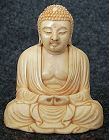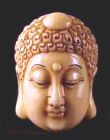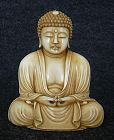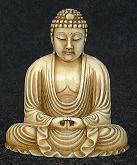


 When talking about miniature Japanese sculptures, the first object that usually comes to mind is the netsuke, a form of miniature sculpture which developed in Japan over a period of more than three hundred years. Netsuke served both functional and aesthetic purposes. The kimono, the traditional form of Japanese dress, had no pockets. Women would tuck small personal items into their sleeves, but men suspended their tobacco pouches, pipes, purses, or writing implements on a silk cord from their obi (kimono sash). These hanging objects are called sagemono. To stop the cord from slipping through the obi, a small toggle was attached. The toggle is called a netsuke.
When talking about miniature Japanese sculptures, the first object that usually comes to mind is the netsuke, a form of miniature sculpture which developed in Japan over a period of more than three hundred years. Netsuke served both functional and aesthetic purposes. The kimono, the traditional form of Japanese dress, had no pockets. Women would tuck small personal items into their sleeves, but men suspended their tobacco pouches, pipes, purses, or writing implements on a silk cord from their obi (kimono sash). These hanging objects are called sagemono. To stop the cord from slipping through the obi, a small toggle was attached. The toggle is called a netsuke.
Okimono, the larger ornamental carvings, are not as well known as yet among 21st century collectors for whatever reason. With the recent surge in popularity of Meiji art, however, and this fine art form in particular, many experts in Asian Art are of the opinion that okimono carvings are entering their golden age.
As the 19th century dawned, westernization brought far-reaching changes to Japan. Artists had to adapt their concepts to the demand of the Western world. As a result of the influence from the West, pockets were now added to the Japanese kimono, eliminating the need for netsuke. During the Meiji period (1868-1912) netsuke were still produced for collectors, but more and more Meiji netsuke carvers began to focus on okimono. Because of the great demand for okimono for export, some artists started to produce objects of an inferior quality. However, there were also many other carvers that created beautifully sculptured okimono and followed the traditional high standard of their craft.
 Okimono were made as ornaments for the tokonoma, the decorative alcove, which is considered one of the four essential elements in the main hall of a noble Japanese residence. Like netsuke, okimono represent Japanese habits and mythology. Buddhist idols and Noh masks inspired many artists when creating these miniature sculptures. However, sculptures of the Amida Buddha, the religious figure which represents the founding of Buddhism as a religion, are rarely found in netsuke carvings but found favor with okimono artists.
Okimono were made as ornaments for the tokonoma, the decorative alcove, which is considered one of the four essential elements in the main hall of a noble Japanese residence. Like netsuke, okimono represent Japanese habits and mythology. Buddhist idols and Noh masks inspired many artists when creating these miniature sculptures. However, sculptures of the Amida Buddha, the religious figure which represents the founding of Buddhism as a religion, are rarely found in netsuke carvings but found favor with okimono artists.
Okimono were carved out of wood and ivory and very often sculptured by netsuke carvers during the Meiji period. Wood was the only material employed during earlier centuries both in temples and Japanese housing. Around the 18th century the use of ivory began to increase. At the beginning of this century, the samisen (a stringed instrument) music became very popular. The plectrum to play this instrument was made out of the center part of the tusk of an elephant. The small pieces that were left over were ideal for the carving of netsuke and, at a later stage, okimono.
 The classification of wood and ivory okimono can be done by school (such as Kyoto or Tokyo schools), but the merit of each object leads to two trends in okimono carving that make the classification more adequate. The first one sticks to the Japanese tradition and can be recognized by strong modeling with striking poses, flowing lines and strongly expressed emotions. Traces of round and flat chisel marks can be found on some of these okimono. For the Japanese art lovers these chisel marks have the same appeal as the brush strokes in painting. The demand from the West lead to the second trend where good craftsmanship was characterized by a smooth surface without chisel marks.
The classification of wood and ivory okimono can be done by school (such as Kyoto or Tokyo schools), but the merit of each object leads to two trends in okimono carving that make the classification more adequate. The first one sticks to the Japanese tradition and can be recognized by strong modeling with striking poses, flowing lines and strongly expressed emotions. Traces of round and flat chisel marks can be found on some of these okimono. For the Japanese art lovers these chisel marks have the same appeal as the brush strokes in painting. The demand from the West lead to the second trend where good craftsmanship was characterized by a smooth surface without chisel marks.
Fine ivory carvings by such notable okimono artists as Gyokuzan, Mitsuji, Yoshiyuki & Meigyoku are featured in the Villa Del Prado Ivory Collection.
 Ivory has had great religious significance to many cultures throughout history. Because ivory is a natural organic material which is at the same time virtually indestructible, ivory has been viewed as having mystical powers that could only be attributed to a deity. Ivory was often used in religious ceremonies and ivory carvings often pay tribute to gods and goddesses... including Shakyamuni Buddha and Kannon (a.k.a. Kwan Yin), the bodhisattva who is considered to be the embodiment of compassion. Elephant ivory became the medium of choice for okimono artists in the 19th century. With the strict regulations surrounding importation and sale of elephant ivory today, the value of antique ivory okimono has skyrocketed in recent years.
Ivory has had great religious significance to many cultures throughout history. Because ivory is a natural organic material which is at the same time virtually indestructible, ivory has been viewed as having mystical powers that could only be attributed to a deity. Ivory was often used in religious ceremonies and ivory carvings often pay tribute to gods and goddesses... including Shakyamuni Buddha and Kannon (a.k.a. Kwan Yin), the bodhisattva who is considered to be the embodiment of compassion. Elephant ivory became the medium of choice for okimono artists in the 19th century. With the strict regulations surrounding importation and sale of elephant ivory today, the value of antique ivory okimono has skyrocketed in recent years.
Closeups of the statues on this page and every sculpture in the Villa Del Prado Light of Asia Collection can be found on the main page.



 When talking about miniature Japanese sculptures, the first object that usually comes to mind is the netsuke, a form of miniature sculpture which developed in Japan over a period of more than three hundred years. Netsuke served both functional and aesthetic purposes. The kimono, the traditional form of Japanese dress, had no pockets. Women would tuck small personal items into their sleeves, but men suspended their tobacco pouches, pipes, purses, or writing implements on a silk cord from their obi (kimono sash). These hanging objects are called sagemono. To stop the cord from slipping through the obi, a small toggle was attached. The toggle is called a
When talking about miniature Japanese sculptures, the first object that usually comes to mind is the netsuke, a form of miniature sculpture which developed in Japan over a period of more than three hundred years. Netsuke served both functional and aesthetic purposes. The kimono, the traditional form of Japanese dress, had no pockets. Women would tuck small personal items into their sleeves, but men suspended their tobacco pouches, pipes, purses, or writing implements on a silk cord from their obi (kimono sash). These hanging objects are called sagemono. To stop the cord from slipping through the obi, a small toggle was attached. The toggle is called a  Okimono were made as ornaments for the tokonoma, the decorative alcove, which is considered one of the four essential elements in the main hall of a noble Japanese residence. Like netsuke, okimono represent Japanese habits and mythology. Buddhist idols and Noh masks inspired many artists when creating these miniature sculptures. However, sculptures of the Amida Buddha, the religious figure which represents the founding of Buddhism as a religion, are rarely found in netsuke carvings but found favor with okimono artists.
Okimono were made as ornaments for the tokonoma, the decorative alcove, which is considered one of the four essential elements in the main hall of a noble Japanese residence. Like netsuke, okimono represent Japanese habits and mythology. Buddhist idols and Noh masks inspired many artists when creating these miniature sculptures. However, sculptures of the Amida Buddha, the religious figure which represents the founding of Buddhism as a religion, are rarely found in netsuke carvings but found favor with okimono artists.
 The classification of wood and ivory okimono can be done by school (such as Kyoto or Tokyo schools), but the merit of each object leads to two trends in okimono carving that make the classification more adequate. The first one sticks to the Japanese tradition and can be recognized by strong modeling with striking poses, flowing lines and strongly expressed emotions. Traces of round and flat chisel marks can be found on some of these okimono. For the Japanese art lovers these chisel marks have the same appeal as the brush strokes in painting. The demand from the West lead to the second trend where good craftsmanship was characterized by a smooth surface without chisel marks.
The classification of wood and ivory okimono can be done by school (such as Kyoto or Tokyo schools), but the merit of each object leads to two trends in okimono carving that make the classification more adequate. The first one sticks to the Japanese tradition and can be recognized by strong modeling with striking poses, flowing lines and strongly expressed emotions. Traces of round and flat chisel marks can be found on some of these okimono. For the Japanese art lovers these chisel marks have the same appeal as the brush strokes in painting. The demand from the West lead to the second trend where good craftsmanship was characterized by a smooth surface without chisel marks.
 Ivory has had great religious significance to many cultures throughout history. Because ivory is a natural organic material which is at the same time virtually indestructible, ivory has been viewed as having mystical powers that could only be attributed to a deity. Ivory was often used in religious ceremonies and ivory carvings often pay tribute to gods and goddesses... including Shakyamuni Buddha and
Ivory has had great religious significance to many cultures throughout history. Because ivory is a natural organic material which is at the same time virtually indestructible, ivory has been viewed as having mystical powers that could only be attributed to a deity. Ivory was often used in religious ceremonies and ivory carvings often pay tribute to gods and goddesses... including Shakyamuni Buddha and 